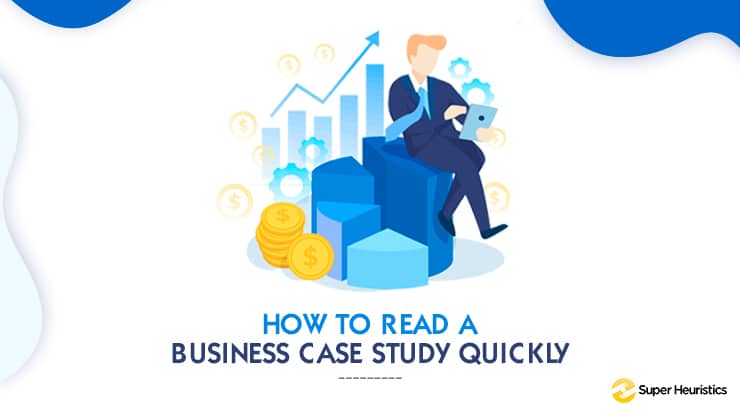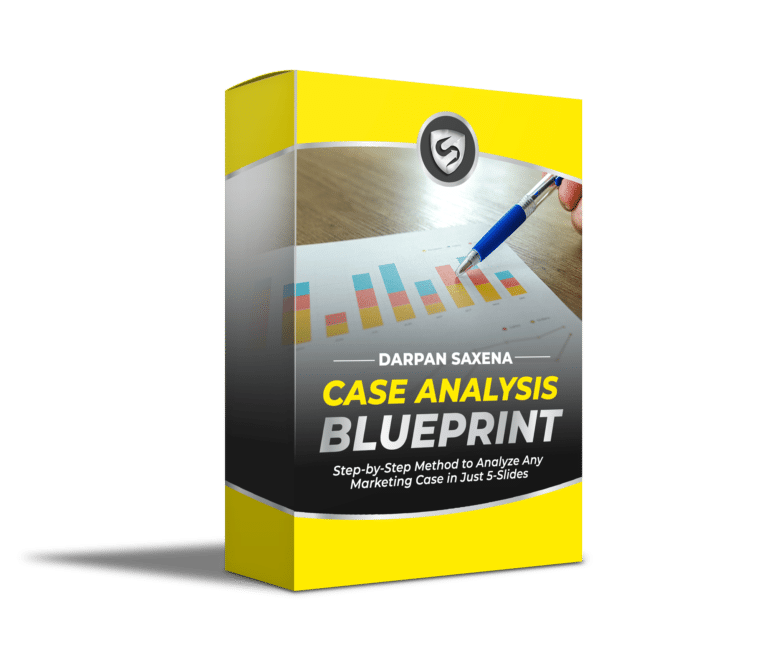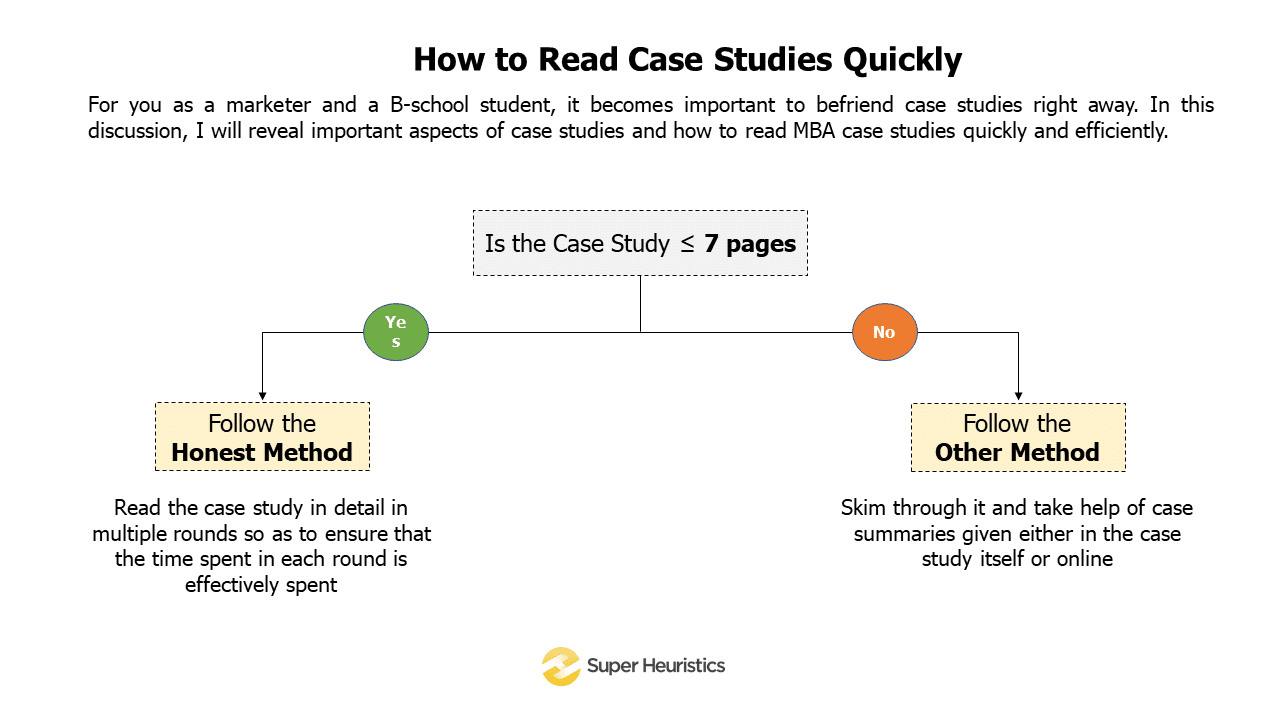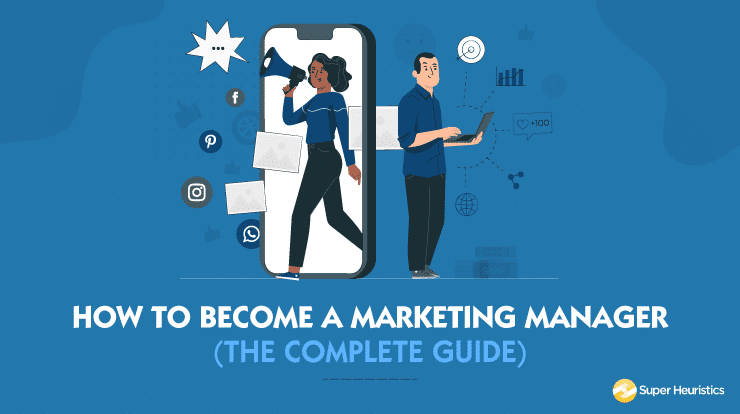
The Case Study Method initially popularized by Harvard Business School is now a dominant feature in the curriculum of all business schools, worldwide. And the fact is they are all over your curriculum too. Probably that's why you want to know how to read MBA case studies quickly.
If you are looking to get into a management course or are currently in a management program, my advice to you is - fall in love with Case Studies already!
They are going to be around you day and night. And the best way to fall in love or to make that love last is to first befriend it.
In this discussion, I will reveal important aspects of case studies and how to read MBA case studies quickly and efficiently. Let’s begin.
What is a Case Study?
Before answering how to read MBA case studies we need to first understand what is a case study.
A Case Study is a document of real-life business scenario or an imagined business scenario. The case study will present to you a problem, issue, conflict, report or impending decision-making that needs to be addressed, solved or analyzed for a business.
As you would know, the Harvard Case Study method is the most widely accepted pedagogy for MBA teaching and training. In fact, a good number of cases in your B-school would be Harvard published cases.
Won't you be interested to learn first-hand from the Harvard Business School about what their case study method is? During my MBA, I was lucky enough to come across this video which shares an insight on what this pedagogy entails for the students.
I urge you to go through this video. This isn't just a description of what the case study method is, but more importantly this is a sneak peak into what is the classroom experience for an MBA student. There would definitely be massive takeaways.
MBA Case Studies - Not Completely Unknown
While it might look to be a big deal, but most of you who have cracked a competitive exam like the CAT, GMAT, XAT or the others of the like have already dealt with a case study like creature before.
An MBA case study may also be looked at as an amalgamation of Reading Comprehension (RC) and Data Interpretation (DI) type of questions.
Yes, the RC and DI sections that you practiced for CAT. A case study may at times resemble an RC set alone and at time may seem like a cross-over between RC and DI set when charts and graphs are given.
I guess now you know why you are tested on Reading Comprehension and Data Interpretation in CAT? These sections check your reading skills, ability to interpret data given to you, evaluate alternatives and make a right decision; which, are all important and required in your management studies and your management career.

Case Analysis Blueprint Course
Learn how to analyze MBA business case studies comprehensively in just five steps
Get to know how to analyze a marketing case study comprehensively in just 5 slides. Which means that the next time you need to analyze a case or participate in a case competition, you would know exactly how to ace the case
Why are MBA Case Studies Important?
A case study is designed to make you step into a manager’s shoes and think like one. What if you are the manager, how would you solve this problem.
Solving a case study would make you explore your analytical, reasoning, leadership and decision-making skills and most importantly make you trust your educated instincts.
Case study method helps you to go a long way in applying your theoretical knowledge and its practical application in a very dynamic and a VUCA world. VUCA, as you may know, is an acronym based on leadership theories that stands for Volatility, Uncertainty, Complexity and Ambiguity.
As a Manager (or a management student) you should be able to provide realistic solutions to the problems presented in a case study. You should be able to explain and justify your decision.
Application of such critical faculties while solving a case study makes it an important feature in the curriculum of an aspiring manager. With each case, you need to change how read and perceive the information and, ultimately, how you think
With the importance of case studies explained, next, is a very important question - How do you solve a case study?
How to Solve MBA Case Studies?
There is no one way to solve a case study. Once you start solving an MBA case study you will have your own take on it. However, listed below are general guidelines that, more or less, remain the same and are effective in solving an MBA case study:
- Place yourself in the role of a leader/manager or as the Harvard Business School likes to call it – Protagonist
- Identify the problem that you face as a protagonist
- Examine the causes for the problems and the issues that are there. Don't worry, you might find conclusive evidences for them. But just form your hypothesis.
- Create alternatives or possible courses of actions that are within the purview of the organization’s goals and objectives
- Get back to your hypothesis and assumptions and choose a course of action that is the most favorable. You most likely will need data from the exhibits to decide on one strategy.
- Put it to vote. Discuss. Brainstorm. Identify possible trade-offs for each alternative
- Suggest a final alternative and justify it
- Discuss the case study with fellow students, professors, colleagues, and note all interesting/new/innovative solutions that others have to offer
- Enjoy the learning and process

Want a step-by-step framework to analyse Marketing Case Studies?
This guide on How to Analyse Marketing Case Studies tells you the methods to tackle a case. What I suggest in the book is an elaborate explanation of how you can present your case study analysis most effectively, in just 5 slides.
But, How to Read MBA Case Studies Quickly?
To the above question I would also like to add “and efficiently”. How to read MBA case studies quickly and efficiently?
I would suggest two ways reading MBA case studies quickly:
- Reading the case study thoroughly when you need to really understand and present it
- Reading the case study super-quickly when you are super-pressed for time
Here's a little thumb rule that you should follow while picking the right method to read your case study.

Just to not spoil you with a slightly lesser honest way of reading cases, I would first be talking about what the correct approach of reading an MBA case study should be.
1
Reading an MBA Case Study Thoroughly [Honest Method]
Here is my standard method of reading MBA case studies efficiently and quickly:
- Before the case is given to you, you would know where it fits into the curriculum. Marketing, Finance, Operations etc.
- You would also know the topics that you have covered or are about to start in the next discussion. This will definitely give you an idea of what you need to do.
- For me, reading a case study for is a 2-3 round affair. And that what makes it quicker, because you are not committed to reading it with full attention in one shot. That's just too much pressure.
- In the first read, which should be a super-speed round, read the sub-headings, read each and every line but extremely brazenly – in speed. No regressing at all. Identify the core scenario of the case and what it is that you are required to do.
- You will experience that there are mostly two kinds of case studies that you will encounter:
- Where you have to take decision as a protagonist or a team leader
- Where no decision making is required, you have to only discuss and analyse the case at hand
- Identify the key players or stakeholders and identify key issues/problems
- Keep your pencil or pen handy. You will be taking notes while solving a case study. Underlining, highlighting would help to reduce the time spent in writing.
- Slow down on statements which have some ‘quotes’ from any of the characters or a line which has numbers. These are things to be read properly and even noted down if required.
- Skim through the discussion questions. Write relevant pointers for each question that you would have picked up from the case’s preliminary reading. Run the scenario in your brain and raise questions as to what happened and why it happened and most importantly what needs to be done.
- Form two or three hypotheses based on your reading. Create a situation analysis, what-ifs, and try to fit the data and the facts in each of them. This could require the 2nd and 3rd rounds of reading to cull-out that data
- Go back to the case - this could be your 2nd read and look for any data that you may have missed. Fill the gaps in your hypothesis. This is where you need to find data from the exhibits.
- Go for a 3rd read if some data is still missing or if you have realized that your initial hypotheses aren't shaping up well an you need to form new ones. Some would prefer to do the 2nd or 3rd read question-wise while others may prefer analyzing the case as a whole
- Now start working on the solving these problems with the data collected
Other way to solve a case is to first read the discussion questions carefully. Then, read the case keeping the questions in mind as a guide to what’s important in the case and what can be ignored.
Now that you know how to read an MBA case study in the most proper way, I am sharing with you a way to read MBA case studies quickly when you are super-pressed for time.
Let me tell you that, this strategy may give you a broad understanding of the case study to do some sort of class participation. But it will not give you enough knowledge which allows you to present the case with its full details.
2
Reading an MBA Case Study Quickly [Partially Honest Method]
I would not be calling a dishonest method. Instead, I am calling it the 'partially honest method' for the reason that I am giving you a benefit of doubt - that while you truly wanted to analyse it and do a meaningful class participation, you happen to be pressed for time.
- The first step would be to quickly flip the pages and get a feel of the case. The headings, sub-headings and words which are in bold will be of help.
- Go to the last page and read the last paragraph. This could be titled as 'Conclusion' in the case study. It could also be titled something else as per the context of the case or their simply may be no heading on this last paragraph.
- Get back to the first page and completely read the introduction paragraph. This would help you understand who is the 'protagonist' of the case.
- From the next heading onward, start reading the first two sentences and the last two sentences of each sub-section/sub-heading.
- By now, you would know three things about the case; the protagonist, the context and what needs to be done by you on behalf of the protagonist
- The next step is where the dishonesty comes in. This is where we go and look for a case summary over the internet.
- Most of the cases that you will encounter will be Harvard Business School (HBS) Cases. The copies of cases handout to you are also available on the HBS website for sale, along with their synopsis.
- Read up the summary and quickly fill up the gaps that you may have in your understanding. In quite a few cases, you may find the summary on other websites.
A big DON'T in any case is this - most of the cases are already solved by students of other B-schools and their presentations are already available on Slideshare or other places.
Do not read these. These would go ahead and 'analyse' the case for you. This would end up making you rigid in your thought process and the class discussion will also not be as fruitful.
Some Examples of MBA Case Studies
MBA case study could be on number of topics.
- A Marketing case study example could be about competitive strategy, pricing, entering a new market, ad campaign, target audience, positioning, etc.
- A Finance case study could be about adopting new accounting policies, evaluating cash flows, debt equity mix balance of the company, etc.
- A Human Resource Management case study could focus on adopting new appraisal format, conflict between employees and management, union conflict, employee benefits etc.
- An Operations case study may include warehousing issues, effective inventory management, improving supply chain management, evaluating raw material suppliers etc.
- A Strategic case study is where you would be presented with problems/issues spanning more than one topic or domain.
Is the solution always going to be foolproof?
No, remember it is a VUCA world. Today’s approach may be cause doom tomorrow. You need to be in tandem with the market trends and give your pinch of innovative thinking.
Will there always be a solution and a conclusion?
No. Just like this article, most of the case studies will not have a conclusion or a single solution. Such cases are more about understanding what happened and why it happened.
Author of this post


Amandeep is devout student and learner of Marketing Trends and Business Strategies. Aman is an MBA in Marketing from the 2015-17 batch. She has spent the better part of her education and subsequent work experience, in gauging, learning and honing the skills that are important for the businesses to remain relevant among competition. To that end, this blog encapsulates the best business and marketing practices for professionals.
Amandeep Kaur Jakhar






